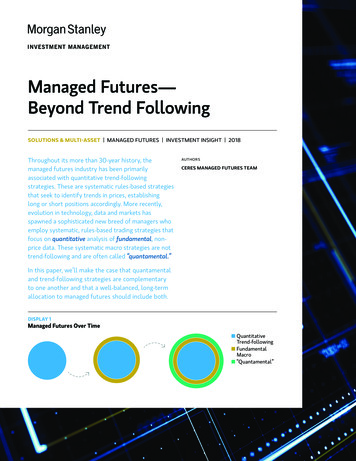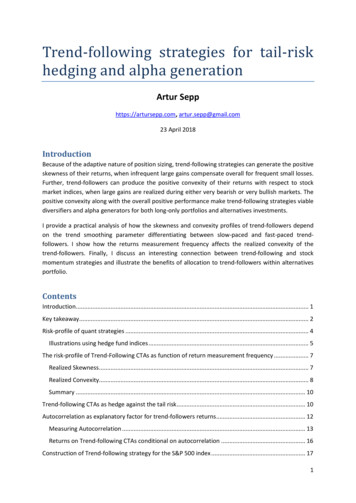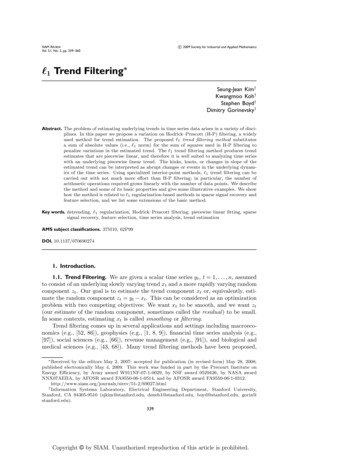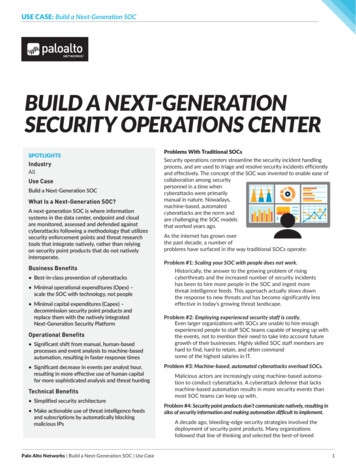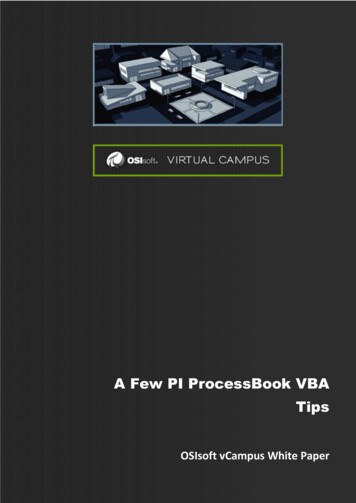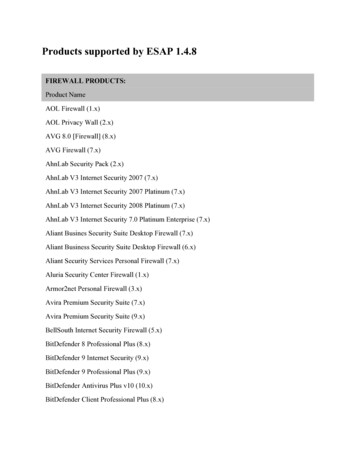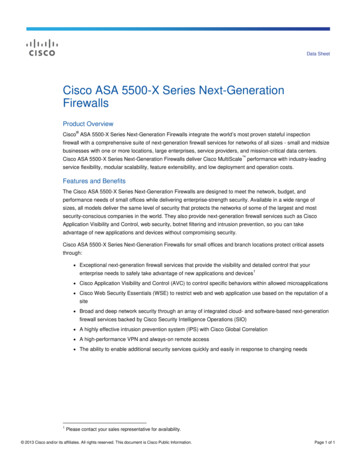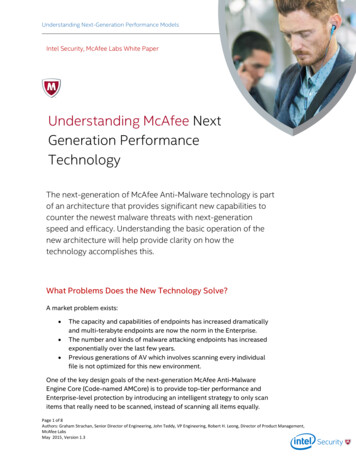
Transcription
Future Trend of NextGeneration VoIPWholesales Platformwww.denovolab.comhello@denovolab.com
Table of Content1 Introduction 11.1 Increasing trunking to IP-based SIP trunking for voice communication11.2 Trading volumes are getting bigger and bigger11.3 Growing number of voice carriers and resellers11.4 Tier One carriers are entering the wholesale space21.5 Technology players are getting into the telecom market21.6 Increased number of spam or unwanted traffic22 What does it mean to be a Next Generation Wholesales Platform ?23 Key Benefits of an Integrated Wholesales Platform33.1 Increased profitability from gaining and sharing visibility into the business33.2 Greater Automation 43.3 Speed of Operation 53.4 Integrated System 63.5 Efficiency in Finance Reconciliation and Dispute Management74 Advanced Features in a Next Generation Voice Wholesales Platform84.1 Real Time Routing84.2 Real Time Reporting84.3 Real Time Rate Updates and Granularity of Rate Definition94.4 Credit Management94.5 Big Data CDR Processing104.6 Multi-Tenant Cloud104.7 Partner portals104.8 Rate Deck Generation and delivery114.9 QoS Routing114.10 Test Call Automation124.11 PCAP Storage 124.12 Trouble Ticket Integration 135. About DeNoVoLab Class 4 Fusion135.1 Fully Integrated145.2 High Performance 145.3 Big Data Approach145.4 Data Centric Design145.5 Distributed Architecture145.6 Automation Support 145.7 Fault Tolerance15
1. IntroductionThe telecom voice wholesales business is undoubtedly a difficult business to be in right now.The impact of free communication apps such as Skype, Whatsapp and Wechat have significantlyreduced the volume in voice calls that everyone makes. Overall, there is much less volumeand Tier One telecoms are reducing the retail rate to their retail clients so as to increase thevolume of their own domestic traffic and also any overseas traffic. All this boils down to reducedmargin per call which, along with lower call volume, has resulted in significantly less profit. Atthe same time, in order for carriers to cope up with greater competitiveness in the business,they need to look outwards to build more interconnections, finding new ways to maintain thesame business profit. Everyone in this industry would agree that the voice wholesales industryis a highly dynamic one, with rate changes every minute. No matter whether volume is low orhigh, a wholesale VoIP carrier has to deal with constant rate changes, routes changes, contractchanges, disputes and trouble tickets all the time.At the same time as VoIP (Voice over Internet Protocol) wholesalers are experiencing erodingprofit, the daily operation has become much more complex and these factors as well as thefollowing industry developments are what is driving the next generation VoIP wholesales platform.1.1 Increasing trunking to IP-based SIP trunking for voice communicationIn the past, wholesales carriers have been mainly using TDM circuits to transmit voice calls.TDM circuits, despite the fact that they terminate voice calls with high quality and guaranteedelivery of service, are expensive to deploy. Nowadays, carriers are rushing to IP-based SIPnetworks to exchange voice traffic and this IP-based voice network has virtually no cost to it.As IP-based networking technology is progressing, the quality of voice call over IP is alreadyas good or nearly as good as TDM. This has made it much easier for new players to enter theindustry, becoming a telecom carrier or wholesales carrier by utilizing VoiP technology.1.2 Trading volumes are getting bigger and biggerThe use of VoIP and SiP (Session Initiated Protocol) trunking has significantly drive down the costof wholesales trading. It costs next to nothing to establish interconnections. Many wholesalescarriers have 500 or even over 1000 trading partners and trade in terms of millions of minutesper day.1.3 Growing number of voice carriers and resellersWith the use of IP, there is very little capital cost for anyone to start up in the business andbecome an ITSP (Internet Telephony Service Provider). Anyone can get a VoIP switch runningfor as little as 500 per month and start trading very rapidly. With a lot more players enteringinto the market, a voice wholesales carrier needs to be able to cope with many more partnersand interconnections in order to take advantage of expansion in route choices and reduced ratesfrom larger partner pools.1
1.4 Tier One carriers are entering the wholesale spaceAs domestic voice volume is decreasing, many global tier one carriers are starting to turn towholesales trading to maintain their revenue. Tier one operators such as Orange, AT&T andVerizon are consolidating their retail call volumes and leveraging this to trade at the wholesaleslevel to 1) drive down cost and 2) increase revenue, by establishing more bilateral partnershipsand swapping their own retail routes with other partners, selling international voice terminationat a global level.1.5 Technology players are getting into the telecom marketPlayers like Microsoft who are entering the telecom space selling voice services with Skype orwhat Google provides with their Google Voice application, is quickly changing the market space.These technology giants may sell voice services at loss but make money on cloud services.1.6 Increased number of spam or unwanted trafficWith the usage of IP and SIP trunking, it is becoming much easier for people to set up anoutbound call center to robo-dial calls out for marketing or fraud purposes. Anyone nowadayscan download some open source software and start robo-dialing. The cost of robo-dialersoftware has been reduced to virtually nothing and as a result, the volume of call center traffickeeps increasing, while the volume of real person to person calling traffic has gradually beendecreasing.These industry wide changes are already being felt in the market and each voice carrier mustface up to them and realistically ask themselves how they should cope going forwarding. A voicewholesales carrier can either take advantage of the trends, ride with them and make them workto their advantage, or risk being outperformed by other companies who see these developmentsas an opportunity, instead of hurdles to their operations.Unlike in the old days, a voice wholesales carrier can’t rely on a good team of people to competesuccessfully in today’s telecom wholesales business. It is much more important to have agreat platform that is equipped with artificial intelligence and automation, one that can fully andsystematically align the entire organization’s operation and workflow. This is the key to successin the industry in the years to come.With this in mind, the purpose of this white paper is to give an introduction as to what a nextgeneration wholesales platform should include.2 What does it mean to be a Next Generation Wholesales Platform ?The idea of fully integrated wholesales platform is not a new one. The idea has been floatingaround in the telecom industry for quite some time already. Many telecom carriers even have alarge in house IT team to build up their own set of automation capability and workflow automationsolutions. For the larger carriers, departmental function is so scattered in different places that2
each party is worried about losing the control they currently do have.Due to the eroding of profit and increasing interconnection, even traditional tier one carriershave no choice but to adopt an integrated wholesales platform approach, in order to save laborprocessing cost, reduce loss arising from human error and increase the speed of response tocustomers.In this white paper, we will cover all the key factors for a wholesales carrier to decide whether toswitch to a next generation voice wholesale platform.3 Key Benefits of an Integrated Wholesales PlatformOne of the key benefits of an integrated wholesale platform is that it’s a central data source forall the variables important to a voice carrier’s business. It includes call detail records (CDRs),rates, payments, invoices, etc.An integrated wholesales platform consists of switching, routing, finance, reporting and customerinteraction in one central data system.The idea of an integrated wholesales platform is to build this intelligence in a closed loop mannerto link up every process in a voice wholesales business, including sales, operation, finance,routing, and billing. As a user of an integrated wholesales platform, the carrier not only gainsspeed and access to real time data, but also accuracy and efficiency in day to day operations.3.1 Increased profitability from gaining and sharing visibility into the businessThe purpose of integrating processes together is so that the entire integrated workflow can bringin much more value to the business as a whole.For example, a network operation center manager may need to know how much traffic wasterminated in the previous month or which clients bring in more profit, in order to allocate limitedcapacity and resources in a more intelligent manner.Likewise, a finance person whose job was primarily to manage accounts payable and accountsreceivables, could now identify whether a route is selling at loss, or if any particular vendor maybring better margins compared to the others.Giving this full visibility to everyone in the business not only helps them to carry out their ownjob more accurately and efficiently, more importantly, it gives the personnel involved a way topoint out potential loopholes and undiscovered profit opportunities.3
Here are some examples we can think about:Opportunity AnalysisWith total visibility into buy and sell rates, an integrated platform can uncover certainaggressive rates that exist for a specific country for a very short amount of time.An integrated wholesales platform can discover specific codes that are selling atbelow market price and give a carrier the opportunity to cherry pick for even a shortperiod of time.ReportingA real-time reporting system give you visibility to check the profit at a client level,vendor level or destination level. You can see for each destination what kind ofmargin you are earning for each client. If one client is offering a higher margin,then it means you can try to offer different terms to your other partners or allocatemore capacity to the client that shows the better profile. A Network OperationsCentre (NOC) can look at this and make routing changes immediately, to generateadditional margin for the company.Pricing AnalysisAn integrated wholesales platform will let you see the quality of route and rate ofroute together on one screen. With this information, NOC personnel can intelligentlyroute traffic based on both the profitability and quality of routing. Sometimes, aroute that has higher margin may have lower Answer Seizure Ratio (ASR). A NOCcan route traffic based on percentage, round robin or least cost routing. A top-notchrouting manager should consider both vendor rate as well as route quality whendeciding how to route each call.Rate GenerationUsually the people who generate rates don’t care about quality of route or theamount of trouble tickets due to a lack of visibility on these statistics. An integratedwholesales platform not only automates the rate generation process but also takeinto consideration the quality of vendors when generating proper rates offers.3.2 Greater AutomationAutomation gives significant advantages to a voice wholesales carrier because it leads to greateraccuracy in every aspect of the business. In the telecoms world, a few mistakes or a dot in thewrong place can be catastrophic, as these can cause a lot of problems in the billing and generatemore disputes. Whenever there is an invoice dispute, this causes the finance personnel a lot ofwork in checking and comparing CDRs. In a typical tier one carrier, each day may have billions4
of call records. The amount of time spent in reconciling disputes and the cost associated with themanual labor involved in this can be as much as the disputed amount.The beauty of an integrated wholesales platform is that it prevents such problems at the rootlevel.Automation can also reduce the amount of manual labor required overall. With an integratedwholesales platform, it is not abnormal to run the entire voice wholesales operation with one ortwo staff at any time.An integrated wholesales platform can significant trim down the labor needed for normaloperations such as:Rate Sheet Generation - When the logic of how a rate deck is supposed to be generated as wellas the delivery of rate deck to client, is fully automated, one can serve more clients with lesstime.Invoice Delivery - With auto invoice delivery, the integrated platform automatically issues invoicesbased on the payment terms of each client. There is no need to compile a bunch of invoices butsimply let the platform handle it automatically. Once set up, invoices get sent out without anyerror or mistake.Automatic Rate Import - Manual rate import is always a key source of error in a dispute situation.With an integrated wholesales platform, rate sheets of different forms and style can be reformattedby the platform automatically without any error.3.3Speed of OperationIn the voice industry, it was standard that there is a week’s notice in advance for all rate changes.This was to allow time for a carrier to upload revised rates and reduce the possibility of chargingerrors due to insufficient staff time to upload changes eg during holiday periods.In many cases the market of voice is changing so fast that now a vendor may change ratesimmediately or if you request an advance notice, the vendor would have to block the route untilthat notice week has passed and the new rate is effective, to reopen the route. This means thatwithin that entire week, the destination may be totally closed off. In voice wholesales this kind ofsituation often happens, especially when there is a national crackdown in SIM boxing or someother sudden political event.Therefore, the ability to be able to react quickly to the changes in the market condition in away that does not increase the possibility of human error is a key capability giving a carrieropportunities to outperform others in today’s voice wholesales business.5
3.4 Integrated SystemMany VoIP wholesales carriers use more than one system, rather than have them integratedtogether. For example, in many carriers, there is separate routing engine, switch engine andbilling engine. The next generation integrated wholesales platform is superior in that there is notonly cost saving in hardware utilization, there is significantly less administration required than isnecessary in maintaining multiple systems. The administrative integration between each systemis in itself a lot of work. This is also a driving force behind why many Tier One operators aremigrating to an integrated wholesales platform.Within the scope of an integrated voice wholesales platform, billing is only one aspect of it. Thereis also routing, monitoring, credit control, finance, reporting, etc. With an integrated approach, avoice carrier can reduce both workload and risk of error on integration of many heterogeneoussystems altogether. There is no need to wait for months to add single features and have themreflected in all systems.Here are some ways a voice wholesales carrier can take advantage of an integrated wholesalesplatform: Ease of communication between departmentsIn the old days, it was necessary for one department to take a screenshot, export the reportfrom one system and send it over to another department. An example is where a NetworkOperation Center has access to a routing report and can tell who is terminating traffic towhom. The finance department can only see CDRs and invoices from the billing platform.When finance needs to reconcile traffic for disputes purpose, there is a lot of downloadingor screen capture that has to take place. On the other hand, a fully integrated wholesalesplatform lets a carrier’s internal department be able to work synchronously on one platformand based on one set of data. Not only is the work more efficient, but also less error prone. Consolidating of origination and termination trafficMany carriers have two systems, one for wholesales termination and one for DID/Originationtraffic. It is not easy for finance to come up with a consolidated invoice without copying andpasting reports from various systems.More importantly, the ability to easily set up routing to route more calls to numbers that areowned by the carrier can be a big cost saving, especially for Tier 1 carriers that have a lot ofDID subscribers. By having both origination and termination traffic together on one platform,a carrier can effectively route calls to their own DID networks and reduce the cost to this onnet traffic to virtually zero.6
Consolidation of international and domestic trafficThe ability to route both international and domestic traffic within one coherent platform isanother huge benefit to a carrier’s routing operation. With the decreasing domestic trafficdue to growing popularity of FREE P2P apps such as Whatsapp, Facebook Messenger, andWechat, each country’s tier one operators are seeing less local traffic. The trend of the nextgeneration integrated wholesales platform is to enable carriers to increase revenue by beingable to terminate international traffic and sell additional products in one platform.3.5Efficiency in Finance Reconciliation and Dispute ManagementAccounts payable and receivable are one of the most important aspects within a voice carrierbecause any delay in processing means losing the trust from vendors and not getting paymenton time. With margins decreasing, it is not uncommon for a carrier to make 1 -2 % profit out ofthe overall revenue. Many carriers are using factoring to finance their traffic flow as well. That iswhy the ability to send out invoices on time and the ability to quickly reconcile incoming invoicesare critical to the success of a voice wholesales carrier.With the help of an integrated wholesales platform, the finance department can quickly pull upreports in real time from live traffic. There is no need to wait for call detail reports to be exportedand then imported to some other reporting system. The data lost due to errors or mistakes in theintegration is also fully eliminated as well.Invoice dispute is very common in the voice wholesales industry. With an integrated voicewholesales platform, the data for each generated invoice is all drawn from the same databaseand therefore, the possibility of error is less and invoicing is much more accurate. When anyclient dispute arrives, a financial team member can easily pull up reports and compare by codeor destination bases more easily, quickly figuring out the reason for any dispute.In the old days, the finance personnel would need to do a lot of manual work including downloadingCDRs, summing up numbers on Excel. Some carriers would even waive a dispute if it wasonly for a few hundred dollars because the cost of labor in reconciling the dispute was just toomuch to justify reviewing the charge. With the efficiency introduced by an integrated wholesaleplatform, the carrier can get accurate reports that they can count on in real time.While terminating traffic, it is very common that one destination may be terminated by morethan one vendor. With thousands of destinations and where each destination can have multiplevendors, it is very difficult to manually figure out the best vendor constitution for each destination.With real-time profitability reporting, finance and routing engineers can in real-time pinpointcases where one vendor is terminating at a much lower rate and therefore, route more traffic tothem for that particular destination. An integrated wholesales platform can not only route callsby least cost routing, but also send out a notification when a cost reduction opportunity exists.7
4 Advanced Features in a Next Generation Voice WholesalesPlatformIn addition to the benefits described above, a next generation voice wholesales platform canbring in much more capability, which we will look at in this section.:4.1Real Time RoutingThe next generation defines real time routing not only by least cost routing, but the platform canalso have intelligence to select routing based on hour of day, day of week, caller-id, as well asreal time statistics such as capacity limit, real time ASR and ACD at the country, destination orcode level.In the older generation of wholesales platform, a carrier would set up batch loading to exportCDR, aggregating data into a report, and regenerate new routing based on historic data andthen import the routing selections back into the routing engine. With today’s latest generation ofvoice wholesales platforms, all data is centralized in one place, the routing engine gets real timeCDR and real time reporting on which to base its routing decisions. There is no need for anyduct taping solution to glue systems together and suffer the unavoidable delays in a scatteredsystems approach.4.2 Real Time ReportingBefore the arrival of next generation voice wholesales platform, it was very common for a voicewholesales carrier to purchase or rent reporting platforms. There are many reporting platformsout there that utilise different adapters to read the call detail reports of their many switchingengines. One can imagine that with this kind of approach, any change in feature in the switchingengine is not easily highlighted by the reporting engine because these are developed by twodifferent parties. Also, there are always delays involved in exporting, importing, and aggregatingCDRs. Many errors can occur even during the transmission of data.In the world of telecommunication, business operates on a 24/7 schedule. There is never asingle minute that there are no CDRs being generated. The more complicated the integrationworkflow is the higher the possibility of errors.With the next generation wholesales platform, everything is all in one, all the time. CDRs is realtime, and reporting is tightly and self-sufficiently integrated. Accuracy and real-time visibilitywork like a piece of cake in this system.8
4.3 Real Time Rate Updates and Granularity of Rate DefinitionIn the old days, a carrier would have separate systems for billing and for routing, along withyet another system for switching. What that means is that when a rate sheet arrives, someonewould have to import it to the billing system, then the routing engine would rank the vendor routeby cost and come up with a routing table, which is then loaded to the switch or the switch wouldquery in real time to the routing engine.The problems in this are twofold. When rate data needs to be propagated from one system tonext, that means there are many opportunities for error. Also, it means there is going to be somedelay before a new imported rate can affect the routing. With international wholesale voicebusiness, rates change constantly and clients expect any decrease to be effective immediatelywith live traffic charged on that new rate. Any delay in implementing a new rate may be apotential loss to the carrier or a risk of clients moving elsewhere.With the introduction of a next generation voice wholesales platform, since data is all integratedin one place, this data centric approach makes it possible for routing to take immediate effectwhenever a new rate is advised and imported. Data for rates can be constantly verified againstneutral third party listing sites which also reduces the risk of delays in updating this information.This instant effectiveness of any rate changes and have it directly imported into the routing logic,is what makes the next generation wholesales platform’s data centric model most competitive.4.4Credit ManagementThere have many many stories about carriers getting defrauded by a client because the systemthey were using did not have the ability to block traffic in real time. This problem has been verysevere for carriers with either prepay or postpay clients.Without an integrated wholesales platform that keeps one single repository of client balance andclient payment history, it is not possible to cut traffic in real time. When billing and switching arein different engines, there are always delays in disconnecting live traffic for clients that are belowthe limit.While some traditionally designed systems do make use of real time querying from switch tobilling engine to obtain the balance outstanding for each client, making it near real time, thissuffers from the following disadvantages:1.It is causing additional PDD ( post dial delay ) when each call generates a requestfrom the switch to the billing engine before the connection is confirmed and created bythe switch. In the wholesales world, each millisecond increase in PDD has a negativeeffect in the ASR of your live traffic.2.When a client is sending a high volume of concurrent calls that have very long duration,checking the client’s balance at the beginning of each call is not going to work because9
when the client’s balance is below the credit limit, there are some calls still in progress.When using the next generation wholesales platform, the data centric approach means thatthe switch has real-time instant access to a client balance without any need for integration.Whenever a client’s balance is below the credit limit, the switch is instantly aware of this withoutany delay or integration and so the switch can cut the in-progress calls accordingly.4.5 Big Data CDR ProcessingIt is not uncommon for a typical voice wholesales carrier to process 100 millions of CDRs aday. Even a small wholesales carrier easily has over million CDRs each day. When it comesto troubleshooting a ticket, it is critical to be able to pull up any CDRs in real time, without delay.So, the ability to store and quickly search for CDRs is an important feature that affects the dayto day operations for all staff within a carrier business.In some countries, such as US, a law enforcement agency may require carriers to keep CDRsfor as long as 9 months.Additionally, a carrier always need to handle plenty of re-rate, which puts a lot of pressure oncarriers to be able store CDRs for a significant period of time. As a result, there is a growingdemand for the next generation integrated wholesales platform which includes cloud storagefacilities such as Google Cloud Storage or AWS. The platform will not just push CDRs intocloud storage but must also retain the ability to query them when needed. That means the nextgeneration integrated wholesales platform needs to keep open access locally such that when auser demands any historical data, it can be quickly and easily returned.4.6 Multi-Tenant CloudThe next generation integrated wholesales platform should support both stand alone deploymentas well as cloud based deployment. By integrating all processes tightly and cutting off all theunnecessary re-integration, a wholesales platform can be run in a much more efficient mannersuch that multiple carriers can share the same set of equipment and create major reductions inCAPEX to benefit everyone in the exosystem.Multi-tenant cloud-based wholesales platforms are especially attractive for medium to smallerwholesalers because everyone shares facilities, renting or leasing as needed at a much lowercost.4.7 Partner portalsIn today’s voice wholesales business, speed is everything and wholesales business is also acustomer service centric one The faster you can get data to your clients, the more clients willstick around. In the next generation voice wholesales platform, a carrier can provide a vendorand client portal for their partners to check CDRs, view reports, file trouble tickets and download10
rate decks. Customer service is significantly improved with no additional labour cost through theuse of fully automated partner portals.Automatic payment submission and auto credit update is also another key factor as well.Especially for prepay clients want to have the ability to pay whenever they want to, even outsidea carriers’ office hours or if closed for national holidays. The ability to instantly accept and updatepayment and credit via a portal is what makes it attractive for clients to continue cooperation witha carrier.4.8 Rate Deck Generation and deliveryIn a typical tier one carrier business, there will be a pricing team that is specifically responsiblefor determining the rate for each country. In order to generate a new rate deck, most carriers useexcel spreadsheets and manually grab rates sheets from different vendors. The problem withthis approach is that it is inefficient, very manually intensive and where in the voice wholesalesindustry rates change every instant, quickly out of date.It is very difficult for a human being to compare manually the new vendor rates and sell rates foreach and every destination. It is very easy for someone to miss out on rate changes or updatea rate incorrectly. While it is possible for a carrier to reconsider the rate changes followingscheduled rates changes, time has already been wasted.With the next generation voice wholesales platform, all the vendor rates and the carrier’sown sell deck is all centralized in one data repository. The platform can therefore, easily andautomatically, generate new rate decks based on the most updated rates on each and everydestination.The other aspect of rate generation is the delivery of the new rate deck to the proper set of clients.Many clients are using mass mailing to achieve this task. With the use of a new generation voicewholesales platform, rate is delivered to each client accurately and automatically. The platformknows which clients are assigned which products and rate decks. Where a new rate deck isautomatically generated, the platform can also send it out d
1.1 Increasing trunking to IP-based SIP trunking for voice communication 1 1.2 Trading volumes are getting bigger and bigger 1 1.3 Growing number of voice carriers and resellers 1 . Verizon are consolidating their retail call volumes and leveraging this to trade at the wholesales level to 1) drive down cost and 2) increase revenue, by .


